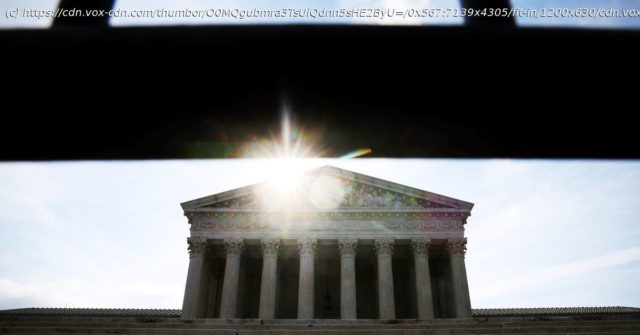The biggest loser was democracy.
The biggest loser was democracy. The Supreme Court just completed its first term since liberal Justice Ruth Bader Ginsburg’s death, and her speedy replacement with conservative Justice Amy Coney Barrett. So the preeminent question on many court-watchers’ minds was just how many victories the Republican Party — and the conservative movement more generally — would rack up in a 6-3 conservative Court. The answer to that question is that Republicans probably got about 80 to 90 percent of what they realistically could have expected. The Court did not neutralize the entire Voting Rights Act, as some Republican litigants basically asked the Court to do, but it hamstrung the one remaining provision it had thus far left intact. The Court also targeted labor unions. It hung a sword of Damocles over laws requiring political campaigns to disclose their donors. And it revolutionized much of the Court’s religion jurisprudence, handing big victories to the Christian right in the process. The term was not a clean sweep for conservatives. But the few high-profile victories for liberals were either very narrow or involved frivolous legal claims that no reasonable judge would endorse. The Court, for example, dismissed an attack on the Affordable Care Act that was widely mocked even by prominent critics of Obamacare. (It’s also normal for conservatives to lose a few high-profile cases after the Court takes a significant rightward turn, because partisan lawyers are more likely to make more dubious legal arguments when they think the Court is on their side.) As several commentators have noted, the Court did seem to divide into three camps for much of the term. The three liberal justices struggled to hold back a growing right-wing tide, while Justices Clarence Thomas, Samuel Alito, and Neil Gorsuch often pushed for bigger and more legally dubious conservative victories. That left Chief Justice John Roberts, Justice Brett Kavanaugh, and Barrett in the middle. But the biggest takeaway from this term is that the Court’s middle is really far to the right. If you’re a conservative, and your biggest complaint about the Supreme Court is that a majority of the justices rejected an anti-Obamacare lawsuit that many Republicans tried to distance themselves from, you don’t have much to complain about. Loser: Democracy Roberts has spent much of his career crusading against voting rights, specifically the Voting Rights Act of 1965, the landmark civil rights law that ended Jim Crow practices disenfranchising Black voters and prohibiting race discrimination of all kinds in elections. As a young Justice Department lawyer, Roberts fought unsuccessfully to convince President Ronald Reagan to veto an important 1982 amendment to the law, which overturned a previous Supreme Court decision making it very difficult to win Voting Rights Act lawsuits. As a justice, Roberts wrote the Court’s decision in Shelby County v. Holder (2013), which neutralized much of the law. He also joined two other opinions severely weakening the rest of the law — the latter of which, Brnovich v. DNC, was decided on the last day of this term. The practical impact of this trilogy is that the Voting Rights Act is barely alive. Under Brnovich, for example, states are likely to have carte blanche to roll back early voting and absentee voting, as well as other, similar innovations that became common in the last four decades. And most challenges to the latest wave of Republican voter suppression laws are likely to fail. And, on top of all of that, the Court’s decision in Americans for Prosperity Foundation v. Bonta, in Justice Sonia Sotomayor’s words, places a “bull’s-eye” on all laws requiring political organizations and campaigns to disclose their donors. Simply put, the Court moved the country several steps closer to competitive authoritarianism this term. Winner: The shadow docket The “ shadow docket ” refers to an array of emergency motions, requests to stay lower court opinions, and other Supreme Court orders handed down without following the Court’s ordinary deliberative procedures. The Court typically spends months pondering cases that receive full briefing and oral argument before the justices. Shadow docket cases, by contrast, are often decided in mere days — meaning that they can often lead to haphazard decision-making if the justices are insufficiently cautious. This risk was on full display this past term, as the Court appeared to take one, extraordinarily aggressive approach in the religion cases that arose on its shadow docket, while also being much more cautious in a case that was briefed and argued. One of the biggest surprises from this past term was the Court’s narrow decision in Fulton v. City of Philadelphia — a potentially very significant religion case that arose on the Court’s ordinary docket. Fulton was decided after the Court handed down several transformative victories for the religious right in shadow docket cases. And these shadow docket cases ruled in favor of religious objectors, holding that churches and other houses of worship could ignore public health regulations intended to prevent the spread of Covid-19. The stakes in Fulton were enormous — though not quite as enormous as the shadow docket cases about whether public health officials may limit the spread of a deadly disease.






